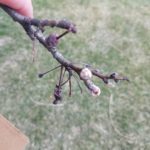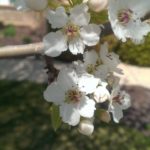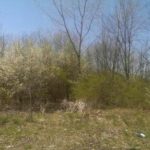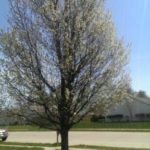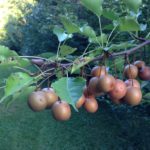It’s that time of the year. Starting in the southern portions of the state and gradually moving north, trees, shrubs, and flowers are beginning to break bud, showing the flowers that have been protected all winter long. One of the first trees that you will notice, increasingly out of place more each year, is callery pear. You probably know callery pear by their cultivar names, such as ‘Bradford’, ‘Cleveland Select’, ‘Aristocrat’, etc.
- Figure 1. Callery pear close to bud break in West Lafayette, IN.
- Figure 2. Callery pear flower.
Bradford pear was a staple specimen in landscapes for decades. For many years the trees never produced fruit, but once other cultivars were introduced to the landscape, cross-pollination allowed fertilization to occur and fruit was thus produced. We will further examine the biology and history of how this occurred in a future article.
The current status and outlook of callery pear is not positive. This species has become highly invasive in many areas around the Midwest, escaping into woodlands and reclamation areas. One of the positive attributes in the landscape, adaptability in growing conditions (i.e. too wet or too dry soil conditions), is a major factor in the invasiveness of the callery pear. Also, the escaped plants tend to grow extremely fast and produce viable fruit at a very young age, which exacerbates the invasiveness of this species.
While driving along the highway, you’ll be able to easily identify the callery pear in flower in the next couple of weeks. This white, flowering tree is unmistakable in early spring. Use this time of flowering to identify for eradication efforts this year on your and your client’s properties.
- Figure 4. Invasive calllery pear flowering in wild area.
- Figure 3. Callery pear in flower in a landscape.
There are many alternative species that can be utilized in place of callery pear. Many of your clients may request callery pear in their landscapes. Educate your clients on the many problems with callery pear, including the life expectancy and invasive nature of this species.
- Figure 5. Fruit set on callery pear. Photo: Rosie Lerner, Purdue Extension.
For alternative options to the callery pear, and other invasive ornamental plants, take a look at this bulletin from Purdue Extension: https://www.extension.purdue.edu/extmedia/ID/ID-464-W.pdf
Purdue Extension information on the invasiveness of callery pear: https://www.youtube.com/watch?v=yvnd13TJUJc
Indiana Invasive Species Council: http://indianainvasivespecies.org/
